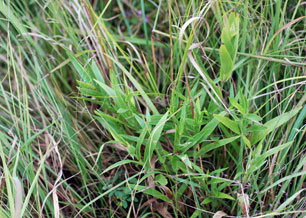LEIBERG DICHANTHELIUM
|
 |
| File Size: 142 KB |
|
|
|
Dichanthelium liebergii (Vasey ) Freckmann
|
| Leavenworth County, Kansas |
| Perennial |
| Height: 8-30 inches |
| Family: Poaceae - Grass Family |
| Flowering Period: May, June |
|
| Also Called: | | Leiberg rosettegrass. | | Culms: | | Erect or geniculate, slender, branching mostly from base, internodes sparsely pilose to glabrous. | | Blades: | | Basal and cauline, ascending or erect; blades 2.4 to 6 inches long, .3 to .6 inch wide, surfaces sparsely to densely papillose-hispid; blades slender and reduced on later branches. | | Sheaths: | | Shorter than the internodes, strongly papillose-hispid. | | Ligules: | | Minute ciliate membrane | | Inflorescences: | | Panicle, pyramidal, open, 3 to 4 inches long, ca. 2 inches wide; branches ascending. | | Spikelets: | | Elliptical, ca. .15 inch, papillose-hispid; florets 2; first glume half as long as spikelet, .06 to .1 inch, acuminate, papillose, second glume .1 to .14 inch, acute, 7-veined, papillose; lower lemma about equaling second glume, 9-veined, papillose, upper lemma .1 to .12 inch, glabrous. | | Habitat: | | Prairies, meadows, open woods; full sun; sandy or rocky soils. | | Distribution: | | East 1/5 of Kansas | | Origin: | | Native | | Comments: | | Leiberg dichanthelium does not produce a large amount of forage. The autumn form is sparingly branched from the middle and lower nodes and produces a secondary inflorescence until early fall. |
|
| Leiberg dichanthelium blades |  | | 100 KB | | Leavenworth County, Kansas |
| | Leiberg dichanthelium blades |  | | 95 KB | | Leavenworth County, Kansas |
| | Leiberg dichanthelium autumn habit |  | | 140 KB | | Leavenworth County, Kansas |
| | Leiberg dichanthelium culm and sheath pubescence |  | | 42 KB | | Leavenworth County, Kansas |
| | |
|
|
|
|
|
|






